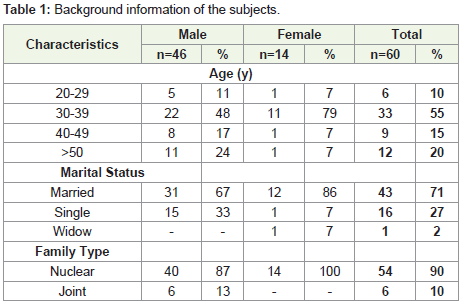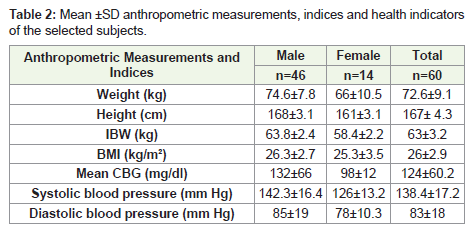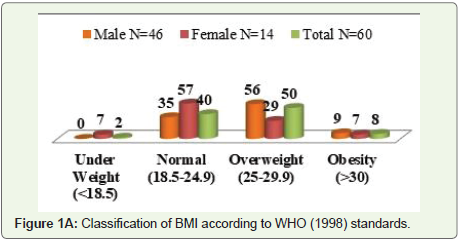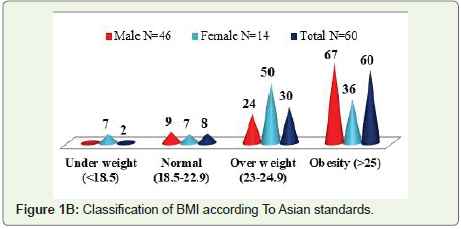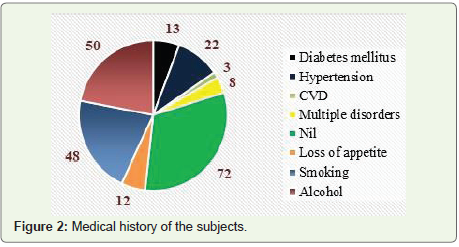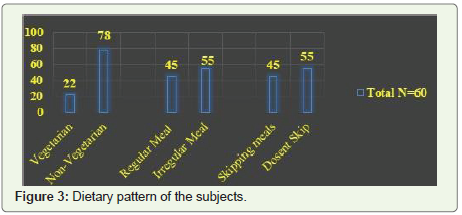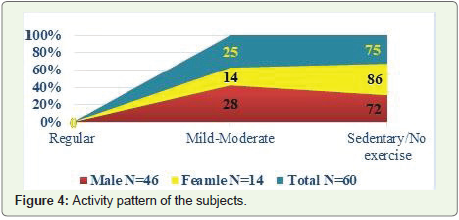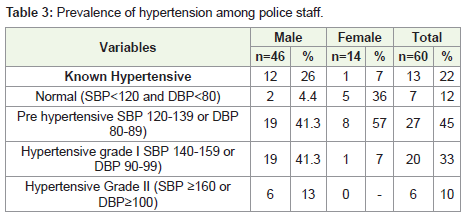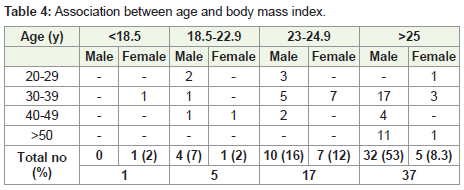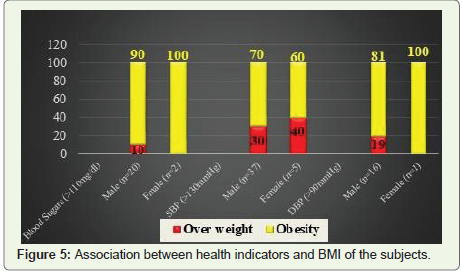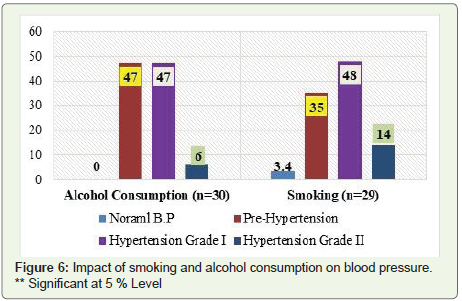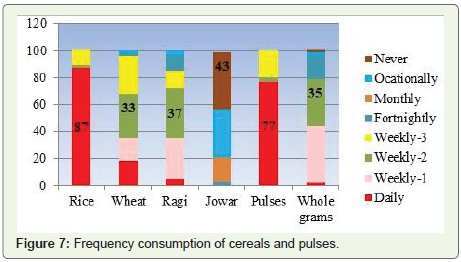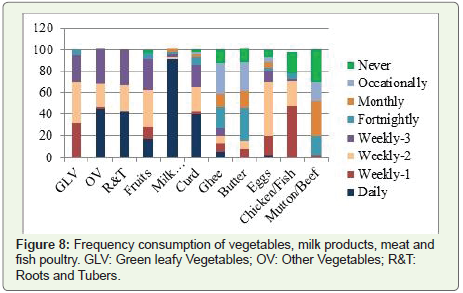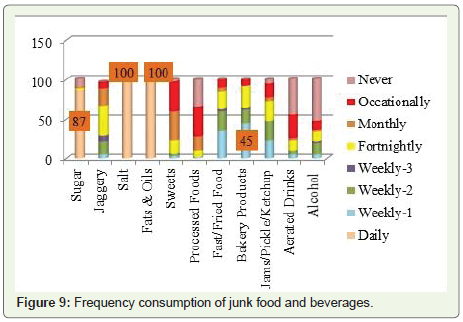Research Article
Dietary Habits and Nutritional Screening of Bangalore City Police
Aparna Nagendra*
Department of Nutrition and Dietetics, Sagar Hospitals-DSI, India
*Corresponding author: Aparna Nagendra, Department of Nutrition and Dietetics, Sagar Hospitals-DSI, Kumarswamy layout,
Bangalore-560070, India, Mobile no: 9845024828, E-Mail: appu31@gmail.com
Article Information: Submission: 09/09/2019; Accepted: 23/10/2019; Published: 25/10/2019
Copyright: © 2019 Nagendra A. This is an open access article distributed under the Creative Commons Attribution License, which
permits unrestricted use, distribution, and reproduction in any medium, provided the original work is properly cited.
Abstract
Police personnel play a vital role in any society by ensuring stability and security. Police work has been regarded as one of the stressful occupation in the
world. The physical threats in police operational duties have been regarded as inherent causes of stress in police work. As hypertension is one of the major
global risks factors, and its prevalence is rapidly increasing worldwide. Individuals with hypertension possess twofold higher risk of developing Coronary Artery
Disease (CAD) and four times higher risk of congestive heart failure compared with normotensive subjects. The policing stage is a very important biophysical
social process in which an inadequate diet may affect the performance and intellectual capacity of individuals. Therefore attention needs to be given on
health, nutrition and life style to prevent chronic diseases. Objective of this study was to assess the dietary habits with nutritional screening and to identify the
prevalence of hypertension among police staff. 60 police staff both men and women between ages 20-60 years from Tyagarajnagar Police Station, Bangalore
were selected as sample for the study. Anthropometric measurements, Dietary history, Systolic and diastolic blood pressures of the police-staff were assessed.
Interview method was used to collect the data effectively using a preformed questionnaire. The police-staff presented with a sedentary lifestyle and dietary
pattern similar to that prevalent in South India. Increase in the BMI (Body Mass Index) indicated overweight and obesity as per the Asian standards. Systolic
Blood Pressure (SBP) showed that Hypertension grade-I (SBP >130 mmHg) and Hypertension grade II (SBP >160 mmHg) was prevalent. Comparison
between BMI and health indicators [Blood sugars and Systolic Blood Pressure (SBP>130 mmHg)] showed that BMI >25 among both male and female. As age
increased BMI increased. Present study shows BMI indicating obesity. It also gives valuable information regarding the present magnitude of hypertension and
certain risk factors among this vulnerable group. A high fat, junk food consumption, sedentary lifestyle, alcohol consumption and long standing effect of this
unhealthy lifestyle may be a major cause of obesity with greater risk for the development of chronic diseases. Reduction in consumption of alcohol, balanced
diet along with other lifestyle modification may help in prevention and control of hypertension.
Keywords
Nutritional status; SBP-systolic blood pressure; DBP-diastolic blood pressure
Introduction
The Indian Police Service is one of the three All India Services
of the Government of India. The Indian Police Service is not a force
itself but it provides leaders and commanders to staff the police and
All India Central Armed Police Forces. Its members are the senior
officers of the police [1]. The Police department is one of the most
significant departments for societal welfare that sustains law and
order in the population [2]. The duties of police are to maintain public
peace and order, crime prevention, investigation and detection,
collection of intelligence, VIP security, railway policing, protection
of environmental laws etc [1]. Police have to work day and night, in
order to keep the public safe and secure. They deal with an array of
unique situations and stresses on habitual basis. In law enforcement,
the police personnel are trained and disciplined in policing for the longest time, however, no guidance are given to them on how to
sustain and safeguard their psychological and physical wellbeing [2].
As changes in the life style made life easier and marked the
beginning of certain chronic ailments such as obesity, cardiovascular
disorders, endocrine disorders and osteoarthritis [3]. Cardiovascular
diseases including coronary heart disease, stroke and hypertension
are the leading causes of morbidity and mortality in both developed
and developing countries [4]. The ‘‘Global Burden of Disease Study’’
has projected Coronary Artery Disease (CAD) and cerebrovascular
disease as the leading causes of death worldwide by the year 2020
[5]. And police are at high risk of developing cardiovascular diseases
due to work related stress where organizational factors such as
work overload [6], time pressure, inadequate resources, manpower
shortage, and lack of support and consultation and communication with the higher authorities in the organization have also been
identified as the potential factors responsible for the stress in the
policemen [7].
And obesity has emerged as the most prevalent serious public
health problem with central obesity being an independent risk factor
for cardiovascular disease. According to the WHO world health
statistics report 2012, globally one in six adults are obese and nearly
2.8 million individuals die each year due to overweight or obesity.
Obesity can also limit activity restricting policemen to desk duty and
may create a dangerous situation while on patrol as it affects swiftness
of action [8].
In India, epidemiological studies have been done extensively
for prevalence of diabetes and other non - communicable diseases
like hypertension among the general population but data on specific
occupational groups are limited [9]. The policing stage is a very
important biophysical social process in which an inadequate diet may
affect the performance and intellectual capacity of individuals; this
may be of special relevance to life quality in developing countries,
where its habitants face adverse socioeconomic, cultural and
nutritional conditions [10]. This study is a modest attempt to identify
dietary habits and nutritional screening of Bangalore city police from
Tygarajanagar and will help in policy making as well as implement
nutrition programmed on them.
Methodology
Study design:
Sample Selection: The study was carried out in Tygarajanagar
police station among 60 police-staff, 46 male and 14 female between
ages 25-60 years who were located in Bangalore and had associated
disorders like diabetes Did you select only those with existing diabetes
or all between the given age group. Approval was obtained from the
Institution, Inspector General of Police before initiating the health
assessment. Consent was taken from the police staff.Somatic status: Anthropometric Measurements-Height (cm)
and Weight (kg) was measured using standardized techniques for
all the subjects. Height was measured using a stature meter (No
26SM model), which has a precision of up to 0.1 cm. The stature
meter was suspended 2 m high from the floor against a straight wall.
The individual was asked to stand upright without shoes with his/
her back against the vertical wall, heels together and eyes directed
forward. Height measurement as appeared in the read off area was
then recorded [11]. Weight was recorded with minimum clothing
and without shoes using an adult weighing scale. Body Mass Index
(BMI) was calculated using the formula (weight in kg) / (height in
m2).Weight status was then classified in accordance to cut off values
for BMI given by World Health Organization (WHO) (1998) and
Asia Pacific classification [12,13].
Blood sugars were checked using a glucometer and the Capillary
Blood Glucose (CBG) was recorded. The Blood Pressure (BP)
was measured using standard mercury sphygmomanometer and
stethoscope by auscultatory method of appropriate cuff size, after 5
minutes of rest with subjects in sitting position, feet relaxed on floor
and arm supported at chest level. Second reading at a 30 minute interval was recorded, if a high BP (≥140/90 mm Hg) was noted. The
lowest of the readings was taken as BP. A person was considered as
suffering from hypertension if Systolic Blood Pressure (SBP) was 140
mm Hg or above and/or Diastolic Blood Pressure (DBP) 90 mm Hg
and above or is already under treatment for hypertension [14,15]. The
subjects were classified as Normal, Pre-hypertensive or Hypertensive
according to JNC VII criteria [16,17].
Personal history:
A preformed questionnaire was used to record their personal
history adopting the direct personal interview method. Dietary
intake was assessed by interviewing in detail regarding type of food
consumed, regular meal timings, number of meals per day, skipping
of meals, food consumption frequency and frequency consumption
of junk foods, processed food, ready to eat food, sugar and salt were
taken. Physical activity pattern, smoking and alcohol consumption
was recorded. Blood pressure was noted and random blood sugar
samples were collected.Interpretation and analysis of data:
Keeping the objectives in mind, the data collected was compiled
tabulated for the appropriateness of analysis. The data was statistically
analyzed using univariate and multivariate analysis. ‘P’ value of less
than 0.05 was considered as statistically significant. Results were then
interpreted; appropriate conclusions were drawn.Objectives
1. To assess the nutritional status of policemen by anthropometric
measurements.
2. To assess the dietary habits by food frequency consumption
and food habits.
3. To determine the prevalence of obesity among policemen.
4. Association between age and BMI among police staff.
5. Prevalence of hypertension among policemen.
Results
A questionnaire was designed based on the needs of the study.
General information regarding age, marital status, anthropometric
measurements, dietary pattern and health indicators like blood sugars,
blood pressure and activity pattern was collected from the selected
subjects adopting direct personal interview method. The study sample
considered 60 subjects with 46 male police and 14 female police and
the age distribution was highly skewed with majority (55%) falling
in the age group of 30-39years and only 20% being middle aged (>50
years) (Table 1). Most of the subjects were married and majority
(90%) of them nuclear families.
Somatic status of the subjects that mean height of the subjects
irrespective of their age group and gender was 167±4.3. Mean body
weight was higher among male compared to female (Table 2). Mean
blood sugars was 124±60.1.
BMI was calculated using Quetelet index based on WHO
classification and mean BMI was found to be 26 kg/m2 ± 2.9 where
majority of them (50%) were falling in the category of overweight and 8% had BMI >30 kg/m2 indicating obesity as shown in Figure 1A.
(WHO,1998) whereas [11], Figure 1B shows categorization according
to Asia pacific classification where, 60% of the total subjects were
obese and among male 60% were obese comparison with female [13].
From Figure 2 self-reported morbidities showed 13% were
diabetic, and 85% had no clinical symptoms. 88% did not have loss
of appetite. 63% and 65% male had a habit of smoking and alcohol
consumption respectively. Figure 3 reveals that 78% were nonvegetarians
and most of them skipped their meals (55%) and also
followed an irregular meal pattern. 75% had a sedentary lifestyle, with
no exercise (Figure 4).
Table 3 provides the prevalence of hypertension among police
staff. Only 12 % of the study subjects did not have prehypertension or
hypertension, clearly indicating a major problem of pre hypertension
or hypertension amongst police personnel. Noteworthy to know that 22% were previously diagnosed with hypertension, and were
on regular antihypertensive medications. Grade 1 hypertension
was reported in 33% where Systolic Blood Pressure (SBP) was 140-
159 mmHg and 10% hypertension grade II (SBP- >160 mmHg).
An association between age and BMI revealed that as age increased
BMI increased with 16% and 53% male being over-weight and obese
respectively when compared to female with 12% over-weight and 8%
obese (Table 4).
Table 2: Mean ±SD anthropometric measurements, indices and health indicators
of the selected subjects.
When BMI was compared with the health indicators like blood
sugars, 90% male and 100% female were found to be obese (Figure 5). Similarly with SBP>130 mmHg; 70% male and 60% female were
lying in the category of obesity. They also had weights greater than
their Ideal Body Weight (IBW). A strong association was seen
between smoking, alcohol consumption and blood pressure among
male police staff. Statistical analysis showed that there is an impact
of smoking and alcohol consumption on hypertension where 47%
and 6% were hypertensive Grade I and Grade II respectively. Among
those who consumed alcohol, none of them were under the normal
blood pressure range. Similarly among the individuals who did
smoking, 48% and 14% were under hypertensive Grade I and Grade
II respectively, which was also statistically significant (Figure 6). Life
style modification with general dietary guidelines was advised to all
the police staff.
Figure 7 provides the frequency consumption of various food
items among the police staff, which showed that consumption of rice
(87%) and wheat (18%) were the most commonly used cereals on a
daily basis, 37% used ragi twice a week but 47% never used jowar.
Among the pulse group 77% of them used pulses daily and 42% were
consuming whole grams once a week. Figure 8 gives information on
vegetable group which was consumed in fair amounts by most of the
staff, where green leafy vegetables were taken twice a week by 35%
and thrice a week by 25%; whereas, other vegetables (45%) and roots
and tubers (42%) were used on a daily basis. Only 17% of the group
consumed fruits daily while 33% and 30% used twice and thrice a
week respectively. Most of them took milk daily (92%) and curd was
used by 40% regularly. As 78% of the group was non-vegetarians, 50%
of them consumed eggs on a weekly basis (twice a week) similarly 48%
were having either chicken or fish once a week. 20% and 30% never
consumed chicken or fish and meat respectively. Salt, fats and oils
showed 100% consumption. 10% never took sugar and 38% showed
occasional consumption of sweets. Fast foods/outside foods or bakery
products was consumedonce a week by most of the police staff 35%
and 45% respectively. 15% had alcohol twice a week (Figure 9).
Figure 8: Frequency consumption of vegetables, milk products, meat and
fish poultry. GLV: Green leafy Vegetables; OV: Other Vegetables; R&T:
Roots and Tubers.
Discussion
Nutrition is the foundation of good health; health is the foundation
of all happiness, skill and performance. Obesity as a health problem
is becoming more widely identified. The enormous economic health
cost of obesity, locates it among the most health care problems [18].
According to the WHO estimates, the undernourished population in
the world has declined and is roughly around 1.2 billion, whereas the
over nourished population has increased to 1.2 billion [19]. A study by
Sukphal Kaur, et al. (2007), observed that where improvement in the
standards of living, decrease in physical activities, dependence of men
on machine, dietary changes and other life style changes have lead
people putting on extra weight.1In the study population, according
to Asia specific classification, 30% female and 60% male were obese.
This is comparable with a study by Komal Rathi, et al. (2018), in their
research on assessment of weight status among police head constables
in Delhi observed a noticeable prevalence of overweight and obesity
among the police constables along with associated comorbidities and
emphasized the need for suitable prevention strategies. 2A similar
study by Moonmoon Hoque, et al. (2016) made an attempt to assess
dietary habit and nutritional status of 100 police staff, and found
that though three-fourth of the respondents were normal in terms of
nutritional status but still one-fourth were overweight [10]. Another
prevalence study conducted by Nadiy, et al. (2013) found that, among
the Malaysian Army (MA) personnel, 32.8% were overweight and 9.3%
were obese [20]. From the study group it was seen that 33% and 10%
had Hypertension grade I and grade II respectively. In a similar study
Ganesh K.S, et al. (2013) revealed the prevalence of pre-hypertension
and hypertension was 37.8% and 34.5% respectively among male
police personnel in urban Pondicherry [14]. In the present study
41.3% male were pre-hypertensive and hypertensive respectively.
The results in Figure 5 indicate that 43% of male and 14% female
exhibited notably elevated blood sugar levels (>110 mg/100 ml); this
result was higher than the 5.7% reported by Karim, et al. (2000) for
adult males in a Saudi Arabian population. Increased body weight
leads to elevated blood sugar levels [21]. Another study by Alghamdi,
et al. (2017) on 160 police officers in Riyadh, Saudi Arabia, found
that among participants with high blood sugar levels approximately
58.3% were obese and 25% were overweight. Blood sugar levels
increased with increasing BMI [22]. Policemen, to relieve from this occupational stress tend to stick to unhealthy habits such as smoking,
consumption of alcohol and smokeless tobacco, and irregular dietary
pattern, and they are not habituated in leisure time physical activity
[23,24]. As a result, they face many adverse effects pertaining to
these habits. It was observed from the study that advancing age was
significantly associated with hypertension among both male and
female police staff and female staff did not have any habit of smoking
or alcohol use, But 47% and 48% male who were smoking and
consuming alcohol respectively where hypertensive (grade I) which is
comparable with the findings of Anurupa Sen, et al. (2015) who tried
to determine the prevalence of hypertension and its associated risk
factors among the policemen of Kolkata, which revealed that notable
numbers of Kolkata-based policemen are hypertensive (32.5%) than
civilians. Age, overall obesity assessed by BMI, SBP and consumption
of smokeless tobacco were the identified risk factors of hypertension
among this group of emergency responders [15]. Ganesh K.S, et
al. (2013) showed that the prevalence of hypertension was 34.5%
and associated risk factors were overweight and obesity (54.4%),
smoking (21.6%), alcohol use (50.3%) [14]. Alcohol consumption
may influence the higher prevalence of risk factors for IHD in police
officers. Potential mechanisms for this relationship include a direct
pressor effect of alcohol on the vessel wall, sensitization of resistance
vessels to pressor substances, stimulation of the sympathetic nervous
system and increased production of adrenocorticoid hormones [25].
Another study on police showed that cardiovascular risk among
police personnel is higher compared to general population in India.
This is because police had higher prevalence of cardio metabolic
abnormalities and diabetes in comparison to general population [26].
Conclusion
The study revealed that overweight and obesity was prevalent
as indicated by BMI among the police staff. It also gives valuable
information regarding the present magnitude of hypertension and
certain risk factors among this vulnerable group. Healthy food
and physical activity provides protection from the health risks of
obesity. Risk factor such as obesity, smoking, and alcoholism also
needs attention in this occupational group. Preventive and remedial
plans should be developed to protect these officers from obesity and
associated complications.
Recommendation
Since the study aimed at providing baseline nutritional screening,
dietary habits and prevalence of hypertension among police personal,
the complete lifestyle patterns were not assessed and further indepth
research is recommended to study the other associated lifestyle
and environmental factors. Not much has been done to determine
the health status of the policemen in Bangalore city and indicate
preventive measures for their upliftment of health. Further studies
involving more police stations across Bangalore city is required to
access the nutritional status of policemen. Without their competent
services, it is next to impossible to keep the city functioning smoothly.
Lifestyle modifications and a regular fitness program targeted at
specific groups such as police personnel who are vulnerable to noncommunicable
diseases is essential to prevent escalation of such
diseases and maintain good health.
Acknowledgement
The authors express sincere thanks to management NU Hospitals
and Tygarajanagar police station authorities for giving an opportunity
to do our study. Dr. Prasanna Venkatesh, Managing Director NU
Hospitals, Bengaluru for permitting us to carry out this study and all
the police staff who patiently took part in the health assessment and
to Dr. Sowmya Rao, Adjunct Faculty, Manipal Academy of Higher
studies, Dubai for her guidance throughout the study.

